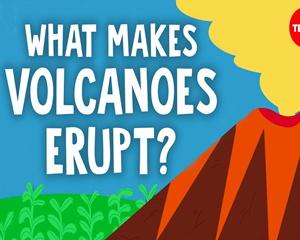In February of 1942, Mexican farmer Dionisio Pulido thought he heard thunder coming from his cornfield.
1942年2月,墨西哥农民狄尼西奥·普利多以为自己听到了从玉米田里传来的雷声。
However, the sound wasn't coming from the sky. The source was a large, smoking crack emitting gas and ejecting rocks.
然而,这声音并非来自于天空。声音的来源是一道巨大的、冒烟的裂缝,正在喷射出气体和岩石。
This fissure would come to be known as the volcano Paricutin, and over the next 9 years, its lava and ash would cover over 200 square km.
日后,这条裂缝将被称为帕里库廷火山,在之后的九年,它的熔岩和火山灰将会覆盖200多平方公里的区域。
But where did this new volcano come from, and what triggered its unpredictable eruption?
但是,这座新的火山从何而来,又是什么引起了它出人意料的喷发呢?
The story of any volcano begins with magma.
任何火山的故事都得从岩浆说起。
Often, this molten rock forms in areas where ocean water is able to slip into the Earth's mantle and lower the layer's melting point.
通常,在形成这些熔融岩石的区域,海水能渗入地幔,降低地幔的熔点。
The resulting magma typically remains under the Earth's surface thanks to the delicate balance of three geological factors.
由于三个地质因素之间的微妙平衡,这些生成的岩浆通常会留在在地表之下。
The first is lithostatic pressure. This is the weight of the Earth's crust pushing down on the magma below.
第一个因素是岩石静压力。也就是地壳的重量将岩浆向下推的力。
Magma pushes back with the second factor, magmastatic pressure.
岩浆的反推力就是第二个因素,岩浆静压力。
The battle between these forces strains the third factor: the rock strength of the Earth's crust.
这场力的较量会作用在第三个因素上:地壳的岩石强度。
Usually, the rock is strong enough and heavy enough to keep the magma in place.
通常,岩石足够坚固、沉重,可以让岩浆保持在原位。
But when this equilibrium is thrown off, the consequences can be explosive.
但是当这种平衡被打破,就有可能产生爆炸性的后果。
One of the most common causes of an eruption is an increase in magmastatic pressure.
火山喷发最常见的原因之一是岩浆静压力的上升。
Magma contains various elements and compounds, many of which are dissolved in the molten rock.
岩浆里含有各种各样的元素和化合物,其中许多都溶解在熔融的岩石中。
At high enough concentrations, compounds like water or sulfur no longer dissolve, and instead form high-pressure gas bubbles.
达到足够高的浓度之后,水或硫这类化合物将不再溶解,而是会形成高压气泡。
When these bubbles reach the surface, they can burst with the force of a gunshot.
当这些气泡到达表面,就可能会以枪击般的力度迸裂。

And when millions of bubbles explode simultaneously, the energy can send plumes of ash into the stratosphere.
当成千上万的气泡同时爆炸,其能量可以将火山灰的烟柱送入平流层。
But before they pop, they act like bubbles of C02 in a shaken soda.
但在爆裂之前,这些气泡就像是摇晃过的汽水里的二氧化碳。
Their presence lowers the magma's density, and increases the buoyant force pushing upward through the crust.
它们的存在降低了岩浆的密度,增加了向上推动地壳的浮力。
Many geologists believe this process was behind the Paricutin eruption in Mexico.
许多地质学家相信这就是墨西哥帕里库廷火山爆发背后的过程。
There are two known natural causes for these buoyant bubbles.
这些上浮的气泡有两个已知的自然成因。
Sometimes, new magma from deeper underground brings additional gassy compounds into the mix.
有的时候,从更深的地底产生的新岩浆会带来额外的气态化合物。
But bubbles can also form when magma begins to cool.
不过,当岩浆开始冷却时,也可能会形成气泡。
In its molten state, magma is a mixture of dissolved gases and melted minerals.
当处于熔融状态时,岩浆是溶解的气体与熔化的矿物的混合物。
As the molten rock hardens, some of those minerals solidify into crystals.
当熔融的岩石变硬,其中的一些矿物会凝固为结晶。
This process doesn't incorporate many of the dissolved gasses, resulting in a higher concentration of the compounds that form explosive bubbles.
这个过程并不会吸收多少溶解的气体,这导致了能形成爆炸气泡的化合物的浓度升高。
Not all eruptions are due to rising magmastatic pressure -- sometimes the weight of the rock above can become dangerously low.
然而并不是所有火山爆发都是由岩浆静压力的上升引起的--有时候,上方岩石的重量可能会降低到危险的程度。
Landslides can remove massive quantities of rock from atop a magma chamber, dropping the lithostatic pressure and instantly triggering an eruption.
山体滑坡可能会从岩浆房的上方带走大量岩石,这降低了岩石静压力,并会立即触发火山爆发。
This process is known as "unloading" and it's been responsible for numerous eruptions, including the sudden explosion of Mount St. Helens in 1980.
这个过程被称为“卸荷”,它是无数火山爆发的原因,其中就包括1980年圣海伦火山的突然爆发。
But unloading can also happen over longer periods of time due to erosion or melting glaciers.
但是由于侵蚀作用或者冰川融化,卸荷也可能长期发生。
In fact, many geologists are worried that glacial melt caused by climate change could increase volcanic activity.
事实上,许多地质学家正在担心由气候变化导致的冰川融化可能会增加火山活动。
Finally, eruptions can occur when the rock layer is no longer strong enough to hold back the magma below.
最后,在岩石层强度不再足以抑制岩浆的地方,火山喷发也有可能发生。
Acidic gases and heat escaping from magma can corrode rock through a process called hydrothermal alteration, gradually turning hard stone into soft clay.
从岩浆中逸出的酸性气体和热量可以通过名为“热液蚀变”的过程侵蚀岩石,逐渐将坚硬的石头变成软质的粘土。
The rock layer could also be weakened by tectonic activity.
岩石层也可能会被板块运动削弱。
Earthquakes can create fissures allowing magma to escape to the surface, and the Earth's crust can be stretched thin as continental plates shift away from each other.
地震会制造出裂缝,令岩浆逃到地表,且当大陆板块彼此远离时,地壳可能会被拉伸变薄。
Unfortunately, knowing what causes eruptions doesn't make them easy to predict.
遗憾的是,了解火山爆发的原因并不会使预测火山喷发变得更容易。
While scientists can roughly determine the strength and weight of the Earth's crust,
尽管科学家们可以大致测定地壳的强度和重量,
the depth and heat of magma chambers makes measuring changes in magmastatic pressure very difficult.
岩浆房的深度和热量使得测量岩浆静态压的变化变得非常困难。
But volcanologists are constantly exploring new technology to conquer this rocky terrain.
但是火山学家们在不断探索新的技术,以攻克这种岩石地形。
Advances in thermal imaging have allowed scientists to detect subterranean hotspots.
热成像技术的发展已经能让科学家们探测地下热点。
Spectrometers can analyze gases escaping magma. And lasers can precisely track the impact of rising magma on a volcano's shape.
光谱仪可以分析从岩浆逸出的气体。激光可以精确地追踪上升的岩浆对于火山地形的影响。
Hopefully, these tools will help us better understand these volatile vents and their explosive eruptions.
但愿这些工具能帮助我们更好地理解这些蠢蠢欲动的火山口以及它们的大爆发。


